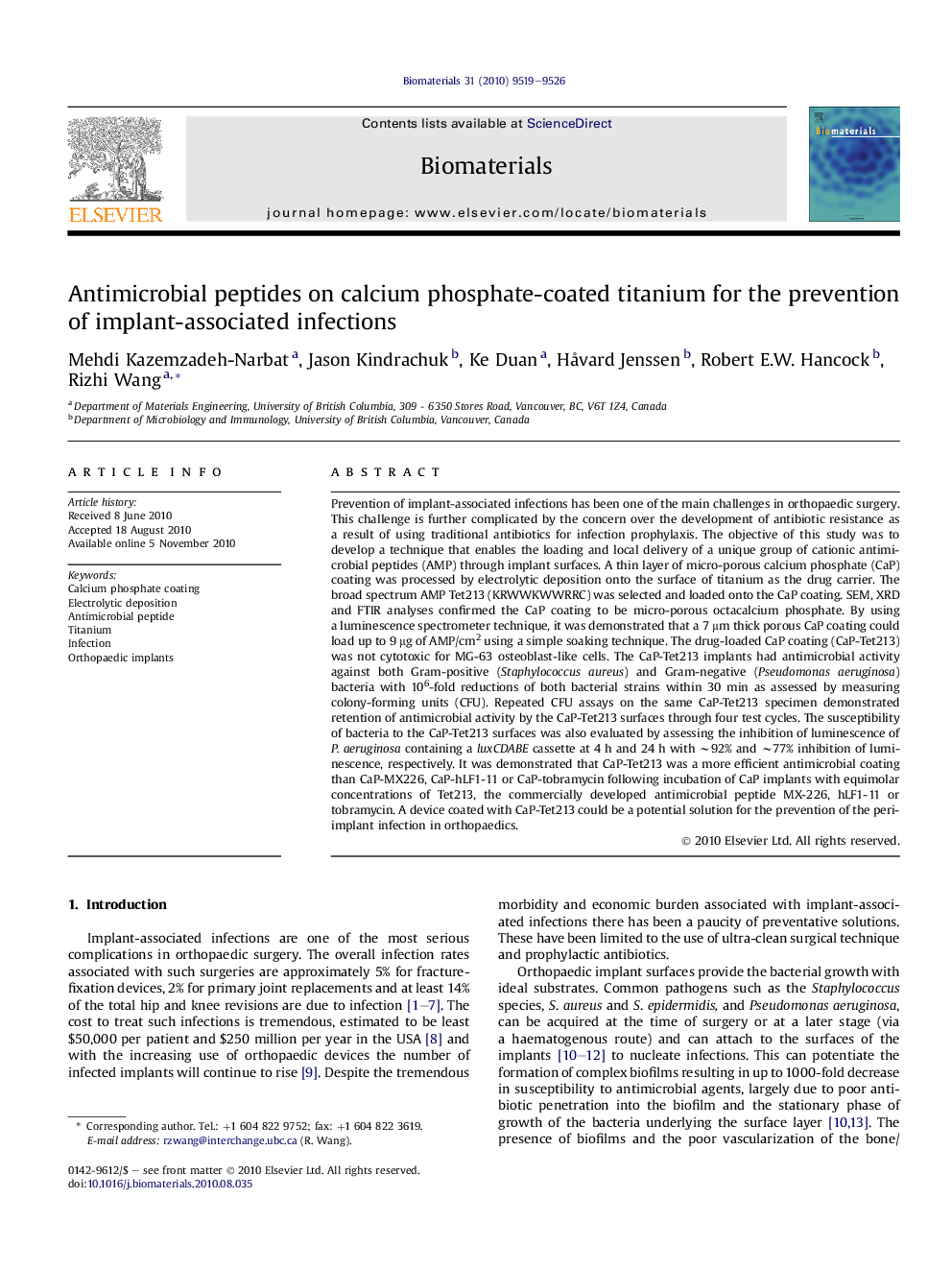| کد مقاله | کد نشریه | سال انتشار | مقاله انگلیسی | نسخه تمام متن |
|---|---|---|---|---|
| 10229993 | 594 | 2010 | 8 صفحه PDF | دانلود رایگان |
عنوان انگلیسی مقاله ISI
Antimicrobial peptides on calcium phosphate-coated titanium for the prevention of implant-associated infections
دانلود مقاله + سفارش ترجمه
دانلود مقاله ISI انگلیسی
رایگان برای ایرانیان
کلمات کلیدی
موضوعات مرتبط
مهندسی و علوم پایه
مهندسی شیمی
بیو مهندسی (مهندسی زیستی)
پیش نمایش صفحه اول مقاله

چکیده انگلیسی
Prevention of implant-associated infections has been one of the main challenges in orthopaedic surgery. This challenge is further complicated by the concern over the development of antibiotic resistance as a result of using traditional antibiotics for infection prophylaxis. The objective of this study was to develop a technique that enables the loading and local delivery of a unique group of cationic antimicrobial peptides (AMP) through implant surfaces. A thin layer of micro-porous calcium phosphate (CaP) coating was processed by electrolytic deposition onto the surface of titanium as the drug carrier. The broad spectrum AMP Tet213 (KRWWKWWRRC) was selected and loaded onto the CaP coating. SEM, XRD and FTIR analyses confirmed the CaP coating to be micro-porous octacalcium phosphate. By using a luminescence spectrometer technique, it was demonstrated that a 7 μm thick porous CaP coating could load up to 9 μg of AMP/cm2 using a simple soaking technique. The drug-loaded CaP coating (CaP-Tet213) was not cytotoxic for MG-63 osteoblast-like cells. The CaP-Tet213 implants had antimicrobial activity against both Gram-positive (Staphylococcus aureus) and Gram-negative (Pseudomonas aeruginosa) bacteria with 106-fold reductions of both bacterial strains within 30 min as assessed by measuring colony-forming units (CFU). Repeated CFU assays on the same CaP-Tet213 specimen demonstrated retention of antimicrobial activity by the CaP-Tet213 surfaces through four test cycles. The susceptibility of bacteria to the CaP-Tet213 surfaces was also evaluated by assessing the inhibition of luminescence of P. aeruginosa containing a luxCDABE cassette at 4 h and 24 h with â¼92% and â¼77% inhibition of luminescence, respectively. It was demonstrated that CaP-Tet213 was a more efficient antimicrobial coating than CaP-MX226, CaP-hLF1-11 or CaP-tobramycin following incubation of CaP implants with equimolar concentrations of Tet213, the commercially developed antimicrobial peptide MX-226, hLF1-11 or tobramycin. A device coated with CaP-Tet213 could be a potential solution for the prevention of the peri-implant infection in orthopaedics.
ناشر
Database: Elsevier - ScienceDirect (ساینس دایرکت)
Journal: Biomaterials - Volume 31, Issue 36, December 2010, Pages 9519-9526
Journal: Biomaterials - Volume 31, Issue 36, December 2010, Pages 9519-9526
نویسندگان
Mehdi Kazemzadeh-Narbat, Jason Kindrachuk, Ke Duan, HÃ¥vard Jenssen, Robert E.W. Hancock, Rizhi Wang,